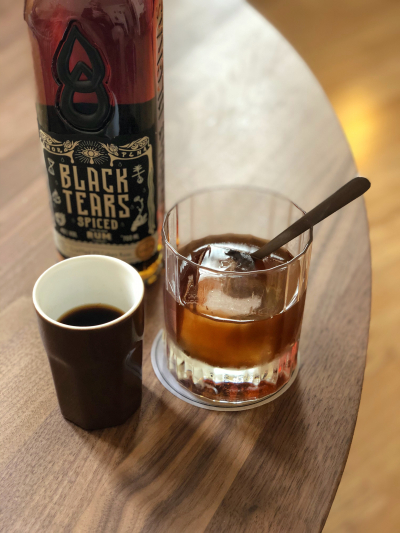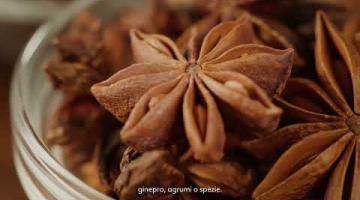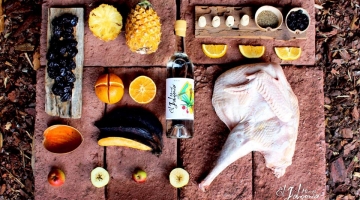Alberto Martinez, owner of Madrid’s 1862 Dry Bar, introduces his city—and shares a Black Tears cocktail too.
A former engineer who changed career after an accident in Mexico, Alberto Martinez is the man behind Madrid’s classic cocktail haven 1862 Dry Bar. Born and raised in the city, he opened 1862 Dry Bar eight years ago after discovering his love for fine spirits in a boutique spirits shop. A driving force behind Madrid’s cocktail scene, he now also co-owns moodily lit hangout Santos y Desamparados.
Three months’ lockdown and ongoing social distancing has transformed the Madrid scene, Martinez says. “In Spain you used to make reservations for dinner but not to go out for drinks and I think this is going to change,” he explains. “There used to be wine bars, tapas bars, much more informal, where you share plates, you eat at the bar, you move around with your beer. Unless there’s a vaccine, that’s going to change.”
Where’s the best place to drink rum in Madrid?
There is a bar called La Ronronera, which is dedicated to rum. It’s kind of small, around 20 capacity. The owner is a rum geek and he goes to every rum festival and lectures on rum and features a lot of the new rum culture in Spain. They focus on the product. If you’re in Madrid and you want to taste different rums and enjoy rum by itself, the place is La Ronronera.
Where’s the best place in Madrid for a drink with a view?
There are plenty of terraces and hotel bars and many rooftops with beautiful views of the city, and at least three hotel bars have a cocktail programme with quality cocktails. But for me, it’s the Circulo Bellas Artes, an old building with a very, very beautiful rooftop and cool drinks, although not an intensive cocktail program.
Where’s the best historic bar in Madrid?
If I had to choose one place for classic cocktails it would be Del Diego, a very classic cocktail bar opened in 1992 by a bartender who started his career in Chicote. They wear tuxedos, they’re very classic with their hospitality. It’s like going to Harry’s Bar in Paris, one of those kinds of bars.
Where do off-duty bartenders go drinking once they finish their shift?
Most bartenders go to Santos for a drink and to have fun after their shift. They have loud music and it’s less formal, it closes a bit later than the other bars. I want to say it’s like El Camion in London—it doesn’t close as late as El Camion, but it’s in the centre and close to all the cocktail bars and if you go there about 2am you’ll find bartenders after their shift relaxing with a beer and a cocktail.
Where can you find the best local ingredients in Madrid?
Not too many people make cocktails at home so there are not many shops open to the public where you can buy ingredients. You generally buy spirits and liqueurs from distributors. Lafuente is good for spirits and mixers for liquors, and if you need to buy specialist ingredients and bartending tools, most people go to Barkonsult. It’s international but they have a shop in Madrid.
Where’s the best market in Madrid?
We are very lucky in Madrid, we have a lot of fresh fruit. Almost every neighbourhood has a local supermarket with all types of fruit and food and almost every street has a fruit shop. I have a Chinese guy with a fruit shop in the same building that I’m in, and I buy all my fruit in his shop, unless I want something very specific, like French ingredients.
Where should we go to eat paella?
I don’t recommend eating paella in Madrid. Paella is from Valencia so in Madrid, people hardly ever eat paella. It’s sad but it’s almost like sangria, where most of the places are tourist traps, with poor quality, poor service and no locals. If I wanted a good rice dish, I would go to a place called Carmencita. It’s a very old tavern in Madrid and they make all the traditional Spanish dishes to a very high quality, especially rice.
Where should we go for coffee?
A lot of good coffee places have opened in the last 10 years. In my neighbourhood, you can find places like Toma Café, if you want modern or speciality coffee. Then you have the old-school beautiful literary cafés, which are normally more for a latte or a cappuccino or an espresso—salons where people used to go to talk during the 1910s and 1920s. Café el Espejo and Café Gijón are two of the best.
Where’s the best place for a selfie?
Madrid is not as monumental as other capitals like Paris or London, but all the city centre, the old part of Madrid, is walkable. My favourite is Gran Via. Around 100 years ago the city decided to make a big street running from east to west and it’s very, very beautiful, with plenty of modernist buildings from the 1920s. It’s very lively in the daytime or at night and there are great cinemas, musicals, and stores.
What’s one thing that everybody who visits Madrid has to do?
Every time a friend of mine comes to Madrid, I go to a place called La Venencia, a sherry bar in Madrid. It’s real old school: they write your bill in chalk on the counter and they only serve sherry and some olives and almonds. That kind of historic tavern is what makes Madrid different from other cities: many are over 100 years old and still family owned. They’re open to all ages, from children to grandpas, and you can go for a coffee after lunch or a beer after work. It’s like the soul of Madrid.
What’s an activity everyone should do in Madrid?
Many come to Madrid to see the football, Real Madrid and Atlético Madrid. Another thing is to go to a flamenco show. Many are tourist traps but you can see a very high quality flamenco show at Casa Patas—although I heard it won’t reopen after Covid, I hope it’s temporary. Flamenco is beautiful. It’s very emotive and part of our culture. Even though it’s not from here, the good flamenco singers and dancers traditionally moved to Madrid, where they could have bigger audiences. You’ll see an amazing show, even if most of the people around you are tourists.
BLACK TEARS, SPANISH STYLE
“I like Cuban culture, so when I heard that Black Tears was moving around the world, I thought it was good for the industry,” Martinez says. While Black Tears’ dry profile is very different from the sweet rum styles most Spaniards prefer, Martinez’s cocktail showcases the spirit’s intense coffee notes in a coffee-chocolate twist on the classic Rum Old-Fashioned.
Café Colonial
60ml Black Tears Dry Spiced
2 barspoons Fresh espresso coffee
1 lump Demerara sugar,
1 barspoon Gingerbread syrup
1 dash Chocolate bitters
Build in a rocks glass like an Old-Fashioned and garnish with an orange twist. Serve with a small cup of black coffee on the side.
















